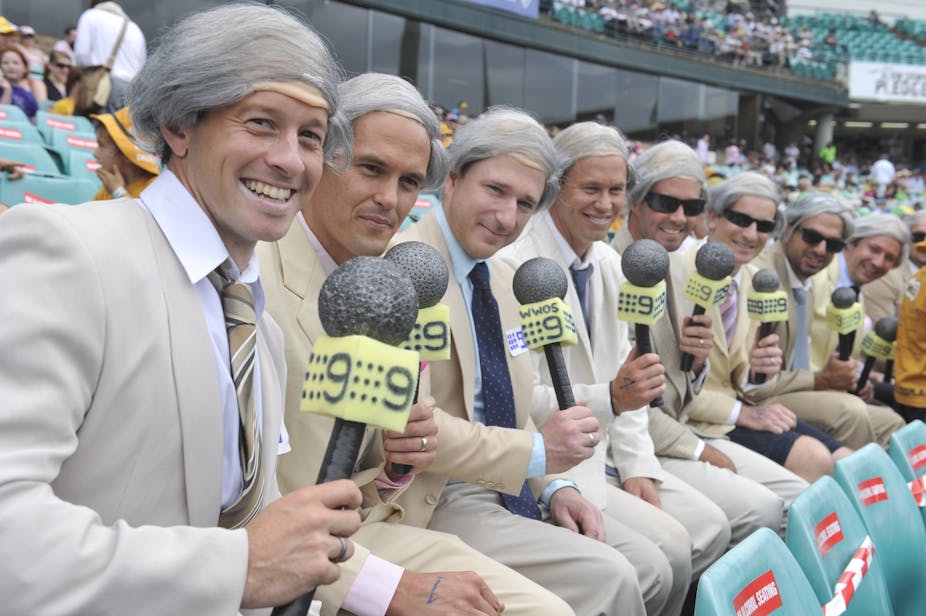Cricket Australia’s Supreme Court legal action against its host broadcaster of the past 36 years, Channel Nine, is the manifestation of an identifiable pattern. It continues a time-honoured practice in Australia of major sports and media organisations shovelling money into the gaping maw of the legal profession.
Examples here include the one-day cricket “revolution” of the 1970s, the Super League and rugby union “wars” of the 1990s, the C7 pay television court battle of the mid-2000s, and last year’s conflict over Optus’ TV Now service.
Together, these multi-million dollar disputes over the control of sports content reveal a mutually reinforcing configuration of sport, media and the law. This triumvirate hoovers up extraordinary amounts of time and money in the pursuit and maintenance of market power.
The disagreement between Cricket Australia and Channel Nine appears to have arisen in the course of broadcast contract renewal negotiations, although the exact sequence of events is difficult to establish given that the legal file has been sealed.
Playing a role in this case is a concerted bid by Channel Ten to take these cricket rights – valued somewhere between A$350-500 million over five years – from Channel Nine. Having just purchased the coverage rights for the 2014 Winter Olympics in Sochi for A$20 million, Ten is pursuing sports rights aggressively in order to revive its flagging commercial performance.
The precise details of the dispute are arguably less significant than how it adds to a lengthy trajectory of legal disputes over sports rights. There are several lessons that can be drawn from over three decades of high profile legal cases, which also suggest these conflicts will intensify in the future.
No matter how much money or power they possess, no single organisation or media company can claim total control over popular sports content. Its popularity acts as an engine for a constant stream of ancillary services and emergent operators that attempt to “get in on the game”.

Operators may include new rival leagues, competing broadcasters, and start-up companies seeking to capitalise on new media platforms and services. This includes, for instance, pay television in the 1990s, the internet during the 2000s, and various forms of mobile media today, including apps, social networking, and location-based services.
Fans now pose challenges because they possess the ability to post their own videos online, run their own websites, access independent news and content providers, and watch “pirate” streams of live television broadcasts on the internet.
The more appealing a sport, the more likely it is that a rights seller or owner will feel the need to take legal action to protect against perceived or actual encroachment on its investment. The exercise of control over content and media platforms seeks to protect revenue streams, even as legal costs erode profits.
The market value of live sport is considerable, but also subject to unavoidable uncertainty in the digital age. At present, alongside reality television, popular elite level sport is the most valuable form of content in the contemporary Australian media market, guaranteeing large and attentive audiences, especially when the result of a game is in the balance.
As Channel Ten’s dogged pursuit of the rights to broadcast cricket shows, broadcasters in particular continue to drive the value of coverage rights ever higher.
Other forms of programming, such as comedy, drama and movies, have not consistently maintained their value when confronted by proliferating viewer choice. The massive growth of online video, on-demand streaming services, and peer-to-peer file sharing has undercut a broadcast business model that has long tied media buyers and advertisers to particular programming genres. The problem for many forms of television now is that viewers decide when they will watch and how, not the networks.
A combination of expensive media investments in live sport and decreasing revenue streams in other areas explains why a rights holder will protect their sports properties aggressively via the legal system.
Attempts to maximise value through the rigid enforcement of contract terms produces a cascading effect of endless legal advice and action. The terms of coverage rights contracts are also subject to constant reassessment when the broadcast of a cricket or football match can appear on a computer screen, tablet and mobile smartphone (with or without permission). As the Optus TV Now case shows, the race to innovate in a world of multi-screen viewing places legislative frameworks under significant strain.
The reality of contemporary sport is that contract law, content packages, platform specific and neutral deals, intellectual property, territorial rights, parliamentary inquiries, and industry codes of practice have as much to do with what we watch as taste, culture and enjoyment.
If Australia is a sports-loving nation, then it is also a litigious one. The pressures generated by shifting audience behaviours, changeable advertising markets and new communications technologies mean that the legal profession will always win no matter what the judge decides.

